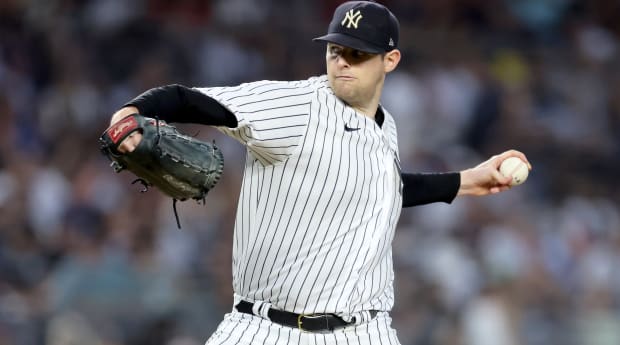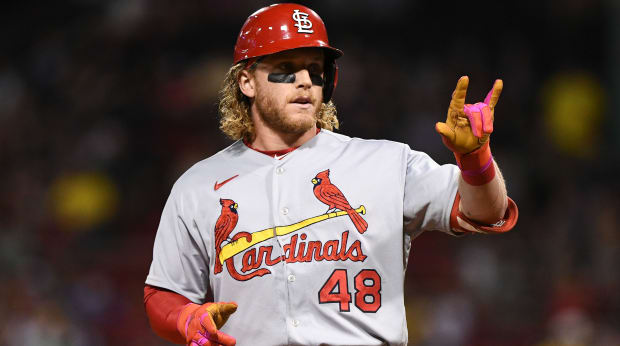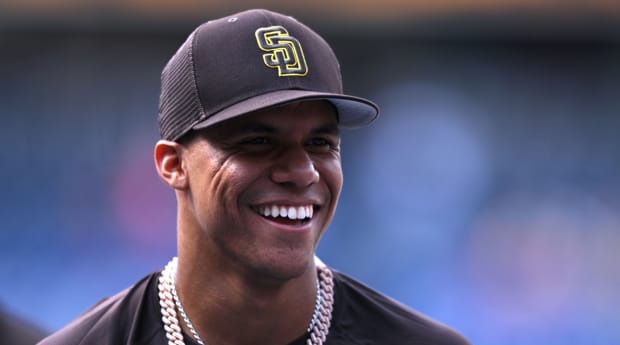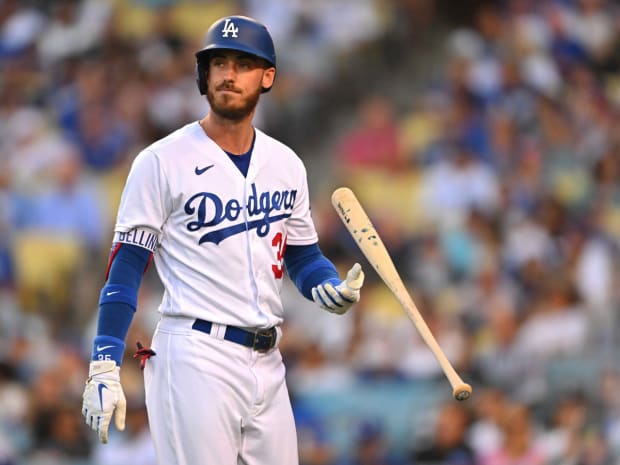
Brad Penner/USA TODAY Sports
There were four different strategies that contending teams used at the trade deadline:
1) Make the necessary moves to improve for the rest of the regular season, with the hope being to secure one of the six playoff spots in each league and/or to ensure home-field advantage.
2) Build the optimal 26-man roster to win in the playoffs, even if that meant winning fewer games in the regular season, or, in the case of the Padres, completely blowing up their farm system.
3) Upgrade around the margins, but don’t do anything drastic.
4) Don’t do anything that could jeopardize the future.
Whether the deals ultimately work out isn’t the point here. Instead, in today’s newsletter, let’s try and understand the thinking behind some of the more puzzling moves that were or were not made, based on which of the approaches each contender took. To do this, let’s divide the teams into four buckets: one for the first each strategy described above.
Bucket 1 - Regular Season: Twins, Braves, Phillies, Cardinals
Bucket 2 - Postseason: Yankees, Astros, Mariners and Padres
Bucket 3 - Margins: Blue Jays, Rays, Red Sox, Mets, Brewers, Dodgers
Bucket 4 - Stability: Orioles, Guardians
Now that we have our groups, let’s take a quick look at a few deadline decisions through the lens of each team’s particular strategy.

Brian Fluharty/USA TODAY Sports
Question: Why did the Yankees swap Jordan Montgomery for Harrison Bader when their biggest need was pitching?
Answer: I know a lot of Yankees fans are not happy about this trade, because Montgomery is about as reliable as a fourth or fifth starter can be and because there are concerns about New York’s depth in the rotation. But, if you consider that the Yankees set out to assemble the best playoff roster possible, the trade makes a lot more sense. Teams use a four-man rotation in the postseason, and after they traded for Frankie Montas, they didn’t have a spot for Montgomery. As things stand, they probably don’t have room for Jameson Taillon in the playoff rotation, either.
- Gerrit Cole
- Frankie Montas
- Luis Severino*
- Nestor Cortes Jr.
Right now, Severino is on the 60-day IL, but all indications are that he will return at full strength in September and be ready for the postseason. If they cannot build him up to carry a starter’s workload, they could use him as a multi-inning relief pitching, which is the role he had in the playoffs last year when he came back from injury. Taillon would likely slide into the rotation as the No. 4, with Cortes moving up to the No. 3. Either way, that’s a formidable quartet, especially with the bullpen reinforcements the Yankees acquired: Lou Trivino and Scott Effross.
Before Tuesday, the Yankees had no true center fielder on their roster. Aaron Judge has been serviceable there defensively, but he’s only playing there because Aaron Hicks is no longer a good defender there. Andrew Benintendi, the other outfielder they acquired, is a primary left fielder. Meanwhile, Bader is an elite defensive center fielder and base runner who is under club control through the end of next season. He’s currently injured with plantar fasciitis, but the Yankees are confident that he will be back by September. Bader probably won’t be an everyday starter upon his return. Assuming Giancarlo Stanton comes back healthy and nobody else gets hurt, Bader will be used off the bench as a defensive replacement or pinch-runner in the playoffs, or as a platoon player with Benintendi. But that’s not a bad thing. In Bader, the Yankees are getting a starting-caliber center fielder who at the very least will be coming off the bench, in exchange for a starting pitcher who probably wouldn’t have pitched much in the postseason, anyway. New York is a better playoff team with Montas and Bader than it is with Montas and Montgomery.
Question: Why did the Cardinals trade Bader, their starting center fielder when he’s not hurt, for someone who might be their fifth or sixth most talented starter when everyone is healthy?
Answer: Well, the short answer is not everyone is healthy. In fact, injuries have ravaged the Cardinals’ rotation for most of the season. Jack Flaherty is the most talented starting pitcher on the team, but he has thrown just 24 1/3 innings in the majors since June 1 of last year. He’s currently working his way back from a right shoulder strain that occurred in late June, after he had already missed the first 69 days of the season with right shoulder bursitis. Dakota Hudson has not been as good as he was in previous seasons; he missed most of last year recovering from Tommy John surgery and just recently returned from a neck strain. Steven Matz is out for the season with a knee injury.
Simply put, the Cardinals are fighting for a playoff spot, either as the NL Central winner or one of the three wild cards, and they desperately needed pitching at the back half of their rotation. So, who better to get than Montgomery? Over the last two seasons, he has a 3.77 ERA over 272 innings. He’s more of a soft contact pitcher than a swing-and-miss guy, and he should fare well with the Cardinals’ elite defense behind him.
Is St, Louis a better playoff team with José Quintana and Bader instead of Quintana and Montgomery? Probably. But the Cardinals need to get to the postseason first before they can worry about that.
Question: How come the Blue Jays didn’t trade for another starting pitcher but thought Whit Merrifield would make for a worthy addition?
Answer: Umm, there isn’t really a way to explain the Merrifield move, because they already have Cavan Biggio to fill the role of utilityman. Their pitching decisions at the deadline make much more sense when you consider their strategy to upgrade their pitching staff, even if it’s along the margins, without jeopardizing the long-term stability of the organization.
Toronto has one of the best starting pitcher duos—Kevin Gausman and Alek Manoah—atop its rotation. José Berríos, who the Blue Jays had expected would give their team one of the most dominant starting trios, struggled for the first three months of the season. But in his six starts since July 1, Berríos has a 3.00 ERA and is striking out 28.2% of the batters he’s faced. Their fourth starter, Yusei Kikuchi, has been quite inconsistent this year, but as the fourth pitcher in a playoff series, he’s serviceable, so long as he doesn’t face an opposing lineup for a third time in a game. Opponents have an .808 OPS against him the first time through the order (mainly because he walks 18.1% of the batters he faces for the first time in a game), and a .724 OPS the second time around. Their collective OPS jumps to 1.079 in their third plate appearance against him. Basically, hitters turn into the 1971 version of Henry Aaron.
So, the Blue Jays decided that adding depth to their bullpen was the best way for them to improve for the final two months of the regular season—to secure home-field advantage in the first round of the playoffs—and to have a chance to make a postseason run without giving up the prospects that would’ve been necessary to acquire Castillo and Montas. On top of that, the Jays felt that the two relievers they got, Anthony Bass and Zach Pop, would be more valuable to them than adding someone like Quintana, Tyler Mahle and Noah Syndergaard.
Anyway, I’d encourage you to use this bucket exercise to answer any other questions you may have about the deadline decisions teams made. And if you’d like to talk through any of them with me, feel free to reach out via email.
This past week was a fun time to be a baseball fan. And there’s a lot more excitement ahead of us over the next few months as we follow the pennant races and then the postseason.
As always, thanks for reading, and enjoy your weekend!
Have any questions for our team? Send a note to mlb@si.com.
1. THE OPENER

Orlando Ramirez/USA TODAY Sports
“The timing of Tuesday’s monumental trade of Juan Soto to the Padres was, to the neutral baseball observer, both a blessing and a curse. The deal went down (at least in principle, try as Eric Hosmer might to delay it) early enough that we weren’t forced to wait on pins and needles all day in anticipation of a resolution. But having the most consequential trade of the day (and perhaps ever?) occur before most of the other transactions were revealed cast a long shadow over the rest of the happenings from what was a wildly eventful day of wheeling and dealing.
“In case you might have overlooked any of the notable non-Soto trades, fear not: We have you covered.”
That’s Nick Selbe, writing in his column this morning about some of the deadline deals that didn’t get enough attention when they happened. It’s a nice, informative breakdown of trades that could have more of an impact on the next few months than you would think.
Most Interesting Under-the-Radar Deals From the MLB Trade Deadline by Nick Selbe
While blockbuster trades stole the show, which subtle moves will prove most significant in a playoff push or total rebuild?
2. ICYMI
Let’s run through some of our other great SI baseball stories from this week.
The Smaller Vin Scully Made Himself, the Larger He Became by Steve Rushin
The legendary broadcaster, who died Tuesday at age 94, had a self-effacing instinct that always failed. His humility is one of the reasons everybody loved him.
The Beautiful Life of Vin Scully by Tom Verducci
He was the ideal orator, a modern Socrates, only more revered, simultaneously a giant and our best friend.
The Padres Are the Ideal Team for Baseball Fans by Tom Verducci
They traded for Juan Soto, Josh Bell, Josh Hader and Brandon Drury. They won the deadline and our hearts for fully committing to try and entertain.
MLB Trade Deadline Winners and Losers by Emma Baccellieri
After a whirlwind of deals unfolded over the last couple of days, let’s review the good, bad and ugly from trade deadline season.
Juan Soto Trade Leaves Crushed Nationals Clubhouse to Root for the Padres by Stephanie Apstein
His former teammates were sad to see him go. They’re also elated to see him play in games that matter.
Grading the Mega-Blockbuster Juan Soto Trade for the Padres and Nationals by Emma Baccellieri
To get the best young hitter since Ted Williams, San Diego stepped up and paid out big.
Mancini Trade Is Cruel Reminder That Orioles’ Rebuild Isn’t Over by Nick Selbe
The most beloved face of Baltimore’s teardown is now playing for the Astros.
Frankie Montas Trade Puts the Yankees Closer to the World Series by Emma Baccellieri
New York added the best available starting pitcher and improved its bullpen depth without giving away its best prospects.
Making Sense of the Puzzling Josh Hader Trade by Emma Baccellieri
The first-place Brewers sent their four-time All-Star closer to the Padres for their closer, a reclamation project of a pitcher and two prospects. Let’s sort through the chaos.
The Weirdest Trades in Baseball History by Lochlahn March
A broadcaster for a minor leaguer? A Hall of Famer for a fence? A shortstop for a turkey? Here are the strangest swaps of all time.
With the Luis Castillo Trade, the Mariners Are Aiming For a Deep October Run by Emma Baccellieri
Seattle made a big move to acquire Reds starting pitcher Luis Castillo. Is it enough to take the team beyond just the end of its two-decade playoff drought?
3. WORTH NOTING from Matt Martell

Jayne Kamin-Oncea/USA TODAY Sports
In 2019, Cody Bellinger led the National League with 351 total bases and 8.6 WAR in 156 games en route to winning the MVP award. In his 248 regular season games played since then, Bellinger has 326 total bases—or 1.3 total bases per game—and 1.2 WAR.
Most of us know that Bellinger’s production has fallen considerably, to the point where there was some speculation over the winter that the Dodgers would not tender him a contract for this season.
The one thing that I’ve been thinking about is whether this is the most drastic decline for any player who won the MVP. Looking back, there were some players whose last great season was the one in which they won their first and only MVP, and whose performances plummeted only a few years later, such as Jackie Jensen, Al Rosen, Dolph Camilli and George Burns. Those four players, though, were older in their MVP years. Rosen was the youngest of the quartet at 29, and his decline, especially at the plate, wasn’t as steep as what we’re seeing from Bellinger.
The only former MVP with a comparable cratering is former Twins shortstop Zoilo Versalles, who won the AL MVP in 1965. Versailles was 25 years old and that year led the league in runs, doubles, triples and, like Bellinger, total bases (308) and WAR (7.2). Over the next three seasons, Versalles had 459 total bases in 419 games—or 1.1 total bases per game—and was worth –1.4 WAR. Based on these metrics, Versalles’s decline was worse than what we’re seeing from Bellinger, but this still means Bellinger's collapse is the worst for any former MVP in nearly six decades.
One more quick thing: I didn’t include 1926 NL MVP Bob O’Farrell, a catcher with the Cardinals, because he really was only a full-time player for three or four seasons, and I don’t think you can compare his career to anybody else who has ever won an MVP. The first sentence of his Baseball Reference Bullpen wiki page sums his odd career up nicely:
“Bob O'Farrell is quite possibly the only 21-season veteran with an MVP award who is not in the Hall of Fame. However, he never had 500 at-bats in a season and only twice had 400+ at-bats in one season, and overall, his numbers were rather unspectacular.”
If you’re interested in this most unusual player, definitely check out that brief bio of his career.
4. W2W4 from Nick Selbe
After yesterday’s loss to the Rockies brought an end to San Diego’s five-game winning streak, the Padres will strut into Dodger Stadium tonight with Juan Soto in tow, ready to showcase their deadline prize in front of a Los Angeles crowd that, not long ago, chanted for the two-time All-Star to be a future Dodger. Instead, Soto will play against the Dodgers, and while it’s true that Los Angeles likely has too big a lead in the NL West to make this a thrilling race, the two squads could very well meet in October, with Soto potentially being the determining factor. So while this weekend’s series is relatively low-stakes, it’s a juicy appetizer for what could be on the way in a couple of months.
Speaking of division races, the NL East is shaping up to be a tight one, and tonight brings the start of a four-game set (with a doubleheader tomorrow) between the first-place Mets and hard-charging Braves in Queens. The pitching matchups over the weekend are appointment viewings: Tomorrow’s first game is a Max-off, Fried vs. Scherzer, while Sunday will pit Spencer Strider against Jacob deGrom. Set your alarms or DVRs accordingly.
5. THE CLOSER from Emma Baccellieri
You’ve probably already seen the details of the Angels’ latest innovation in confusing, soul-crushing ways to lose: Yesterday, they hit seven home runs, all of them solo shots, only to fall to the A’s by a score of 8–7. Naturally, Shohei Ohtani hit two of those dingers (cue the “Tungsten Arm” O’Doyle tweet). They’re the first team ever to hit seven or more solo homers, fail to score outside of that, and lose. Which… hey, that’s the current manifestation of the Angels. But they’re certainly not alone in taking a loss after homering seven times. While that used to be all but impossible—it happened just once before 2000—it’s now happened three times in the last three seasons. The Blue Jays did it in ’20. The Twins did in ’21. And now the Angels have done it in ’22, albeit with their own weird, sad twist.







